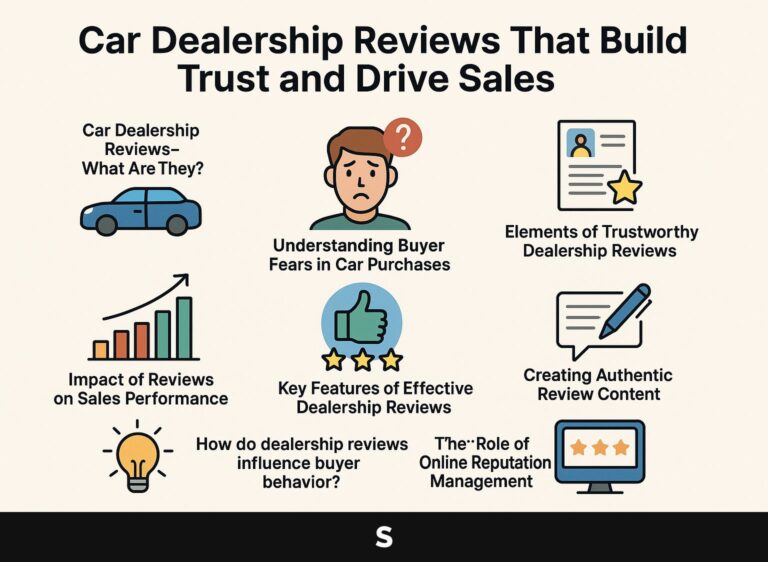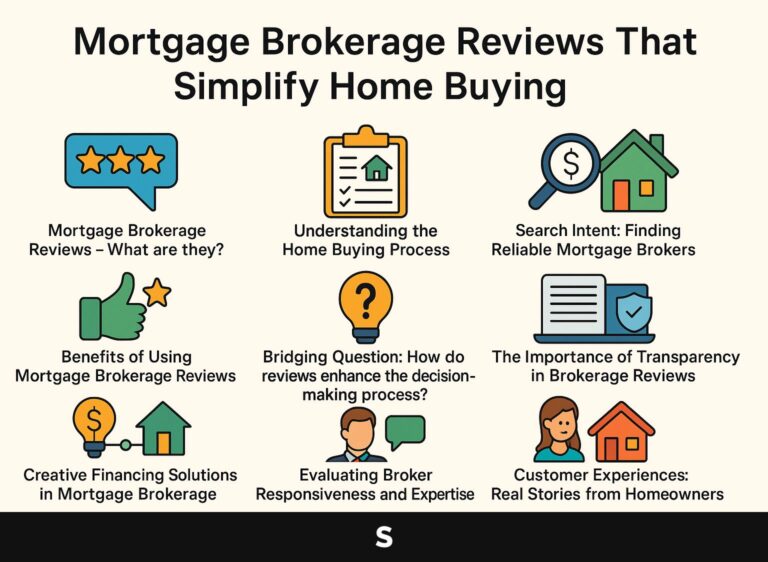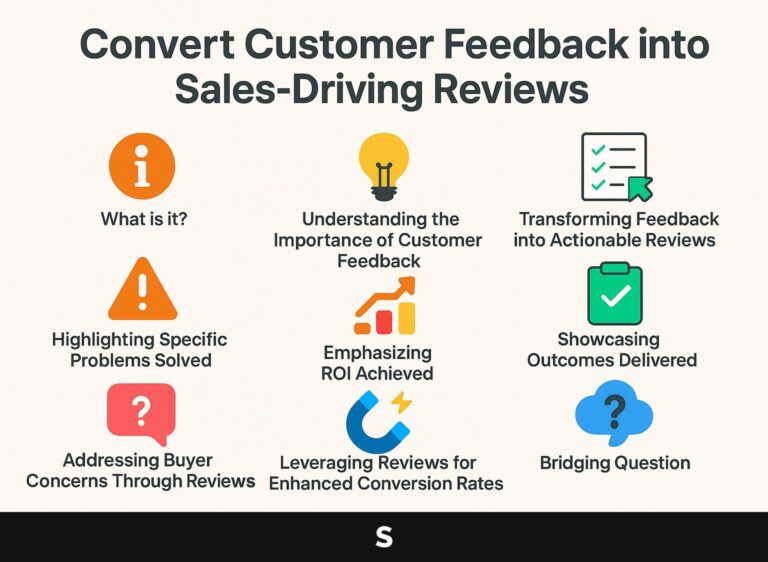Get Patient Reviews That Mention Your Medical Staff by Name

Patient reviews are very important for healthcare providers wanting to improve their online visibility, particularly on sites like Google My Business. Spokk.io’s staff attribution feature lets you make sure reviews mention your doctors and nurses by name, building personal connections with potential patients. This article looks at how using specific feedback can increase trust, highlight team performance, and improve your medical practice’s reputation.
Key Takeaways:
- Get Patient Reviews That Mention Your Medical Staff by Name
- Why are patient reviews important for healthcare providers?
- How does Spokk.io’s staff attribution feature work?
- What are the benefits of mentioning staff by name in reviews?
- Bridging Question
- What strategies can healthcare providers use to encourage named reviews?
- How can healthcare facilities promote their staff through reviews?
- What role does AI play in managing patient feedback?
- How can healthcare providers respond to patient reviews?
- What are the challenges in obtaining patient reviews?
- What new developments are appearing in patient review systems?
- Frequently Asked Questions
- What is Spokk.io’s unique staff attribution feature?
- How does Spokk.io gather patient reviews that mention medical staff by name?
- Why is it important to get patient reviews that mention medical staff by name?
- How does Spokk.io keep patient reviews in line with HIPAA rules?
- Can patients leave negative reviews that mention medical staff by name?
- What are the benefits of using Spokk.io’s staff attribution feature for healthcare reviews?
Get Patient Reviews That Mention Your Medical Staff by Name
When patients leave reviews on platforms like Spokk.io, they can mention their healthcare providers by name. This helps to make the feedback more personal.
What is staff attribution in patient reviews?
Staff attribution allows patients to mention specific doctors or nurses in their reviews, making the feedback more personal.
This system helps gather more detailed information since patients can give specific feedback based on their personal experiences.
For instance, on platforms like Spokk.io, if a patient praises Dr. Smith’s attentiveness during their recovery, it highlights specific attributes that may not be evident in generic feedback.
On the other hand, if someone talks about a bad time with Nurse Johnson, it leads to immediate follow-up and chances to make things better.
By being specific, healthcare providers can better see how staff members perform over time, which helps with team training and leads to better results for patients.
Why are patient reviews important for healthcare providers?
Patient reviews are important for healthcare providers because they directly affect patient trust and choices in an online healthcare market. Understanding this, it’s crucial for providers to know how to effectively handle and interpret feedback. Expert insights on mastering customer feedback analysis can greatly enhance this process-our framework for feedback analysis elaborates on how to derive actionable insights from reviews.

How reviews affect patient confidence and choices
Studies show that 84% of patients trust online reviews as much as personal recommendations, highlighting their significant impact on healthcare decisions.
This trust comes from different psychological reasons. Social proof is important; when potential patients see many positive reviews, they view the healthcare provider as more trustworthy.
Feelings affect decisions; sharing personal experiences in reviews can build trust and help others relate. Healthcare providers should ask happy patients to write reviews.
Tools like Google My Business and Healthgrades can make this process easier, collecting feedback directly and increasing visibility. Regularly monitoring these platforms helps providers address concerns and build a solid online reputation.
Influence on online reputation and visibility
Positive patient feedback enhances a healthcare provider’s online reputation, increasing their visibility on platforms like Google My Business and Healthgrades.
More positive reviews can improve a provider’s placement in search results, which can lead to more patient inquiries. For instance, a clinic with an average of 4.5 stars and over 100 reviews may appear above competitors with similar services but lower ratings.
Healthcare providers should ask for feedback through follow-up emails or text messages after recent visits, using tools like Trustpilot or SurveyMonkey.
Responding to reviews-both positive and negative-further engages potential patients, demonstrating a commitment to quality care.
How does Spokk.io’s staff attribution feature work?
Spokk.io’s staff attribution tool simplifies the patient review process, ensuring feedback is personal, helpful, and complies with HIPAA regulations. For those curious about how this compares to other platforms, our tool is often highlighted in discussions about why Spokk.io surpasses alternatives like Delighted.
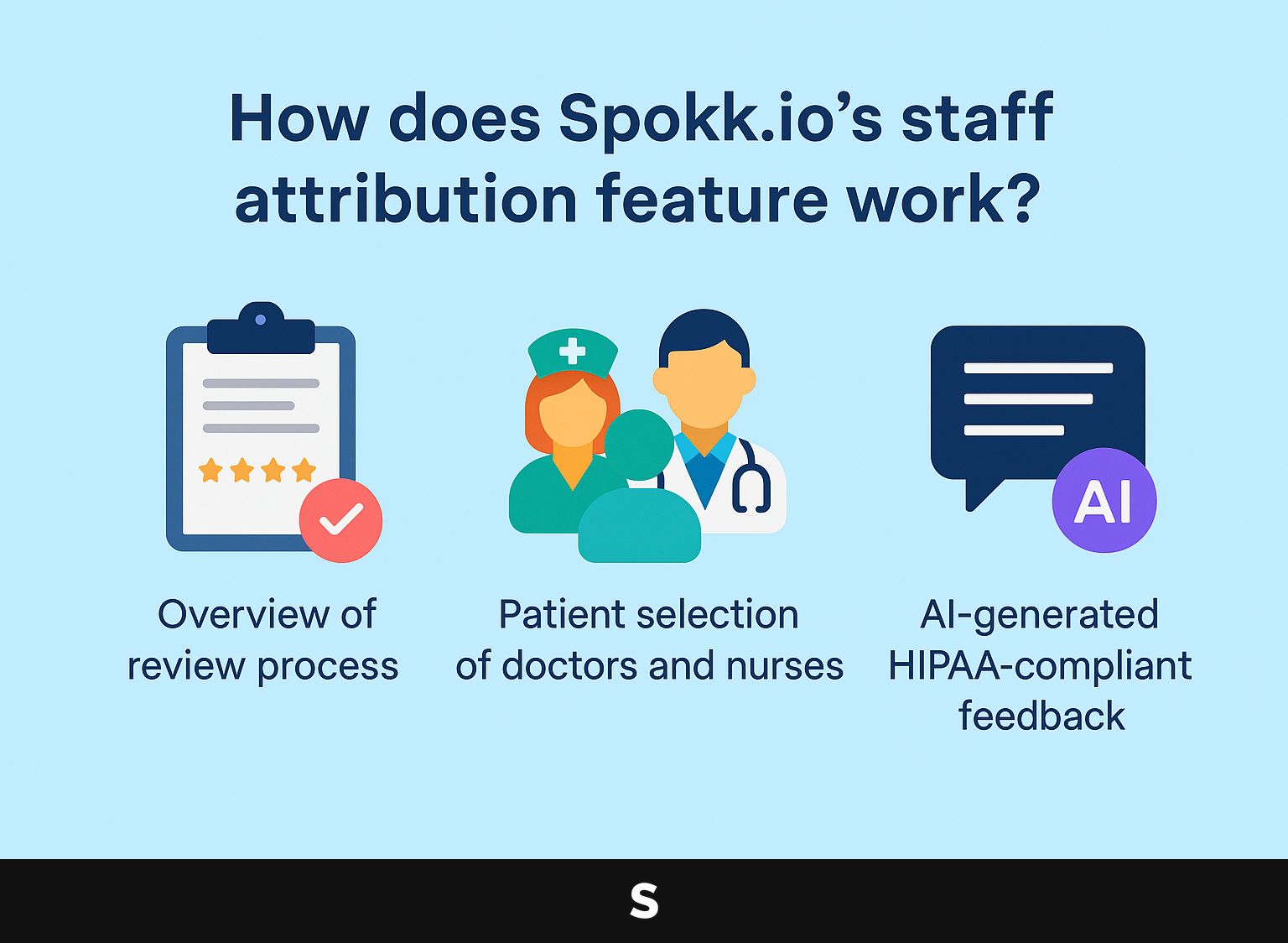
Overview of the review process
The review process on Spokk.io begins with patients selecting their healthcare providers, which allows for targeted feedback on specific team members.
After choosing a provider, patients are asked to respond to particular questions about their experience, including communication, waiting times, and general satisfaction.
Spokk.io uses numerical scores and written opinions to provide thorough feedback. This information is then made anonymous and arranged into simple summaries for healthcare providers, helping them spot areas that need improvement.
To maintain compliance, Spokk.io follows strict data privacy regulations, ensuring that all patient information is safeguarded throughout the process.
Patient selection of doctors and nurses
Patients can choose their favorite doctors and nurses when providing feedback, which makes the experience more personal and improves their overall satisfaction.
This choice improves satisfaction and gives healthcare providers specific information. For example, if multiple patients commend a particular nurse’s empathetic approach, facilities can prioritize training similar practices among staff.
Using patient experience software like Press Ganey or Qualtrics allows providers to analyze reviews by specific healthcare professionals, identifying strengths and areas for improvement. This better feedback process can strengthen patient loyalty and improve care quality.
AI-generated HIPAA-compliant feedback
Spokk.io uses AI to produce reviews that follow HIPAA rules, keeping patient comments confidential while still giving useful details.
To achieve this, Spokk.io employs advanced algorithms such as natural language processing (NLP) and machine learning (ML).
NLP finds and summarizes main points from patient feedback while protecting personal details. ML improves the feedback process for accuracy as it gains more data.
The platform uses data encryption to protect all patient information, following HIPAA rules. This two-step process protects information and makes sure reviews are complete, offering useful feedback to healthcare providers.
What are the benefits of mentioning staff by name in reviews?
Naming staff in reviews helps build a stronger connection between patients and providers, bringing many benefits to healthcare practices.
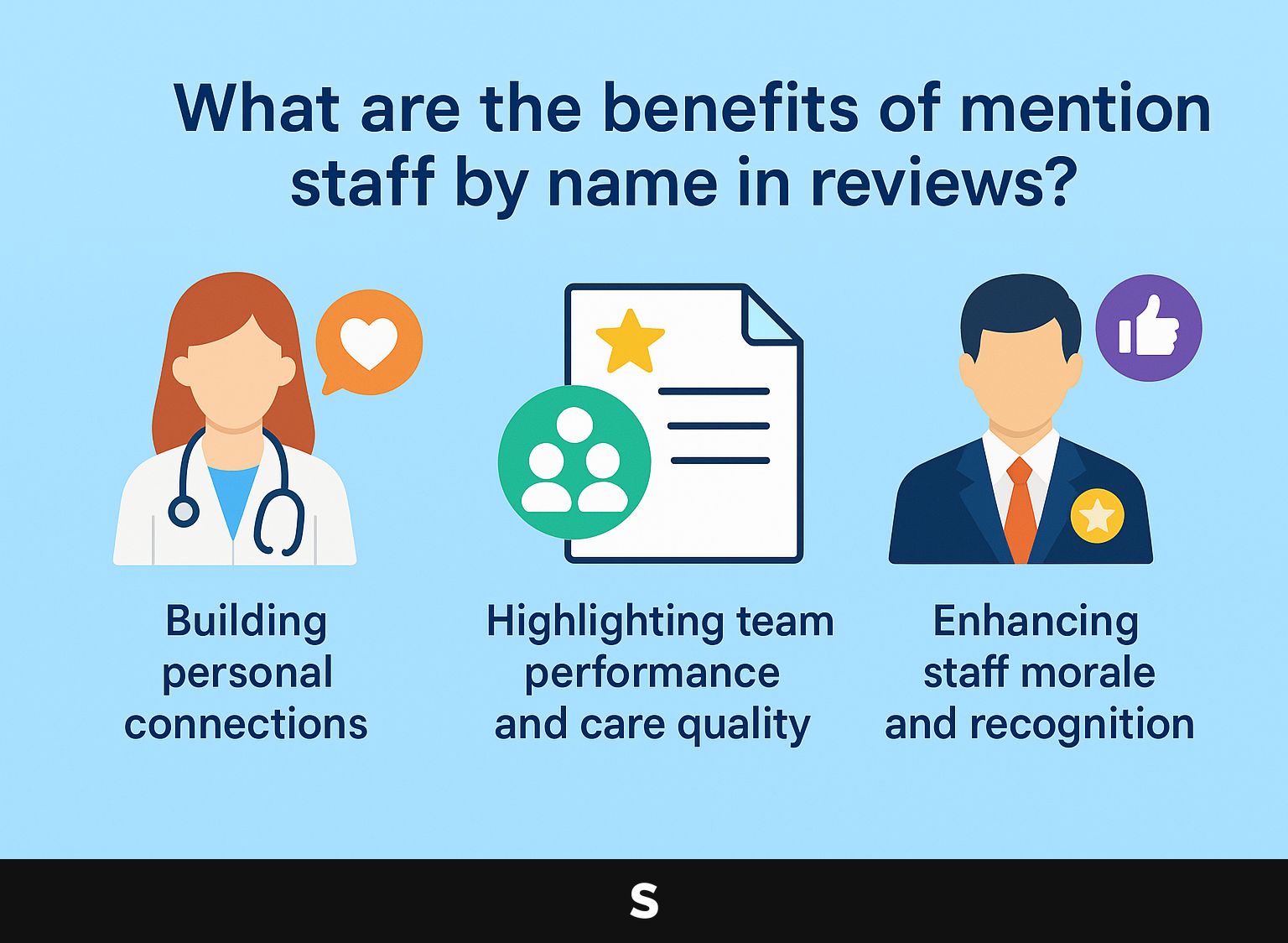
Building personal connections with patients
Personalizing patient feedback by mentioning staff can lead to stronger emotional connections, resulting in higher patient satisfaction and loyalty.
Studies show that up to 70% of patients are more likely to return if they feel a personal connection with their healthcare providers. Using tools like email surveys for patients or sending handwritten thank-you notes for personalized follow-ups can have a positive effect.
Mentioning particular staff members in online reviews can make this connection stronger. For example, when patients share their experiences with specific staff members, it acknowledges the team’s efforts and creates an environment where patients feel valued. This appreciation makes them more likely to return.
Highlighting team performance and care quality
Named reviews show how well healthcare teams are doing, offering details about care quality that can lead to better operations.
To make the most of comments from specific reviews, healthcare providers should emphasize the strong points of each team member. This can involve showcasing patient testimonials that mention specific staff, thereby promoting a culture of accountability and excellence.
Metrics such as patient satisfaction scores, response times, and follow-up care effectiveness can serve as performance indicators. Regularly analyzing these metrics allows teams to identify areas for improvement.
For example, a team might find that follow-up care rates are low, causing them to look at their outreach methods to improve patient involvement.
Enhancing staff morale and recognition
Recognition through patient feedback can greatly improve staff morale, create a better work environment, and increase staff retention rates.
Healthcare providers can use positive feedback in many important ways.
- Start by regularly sharing patient compliments during staff meetings to celebrate individual contributions.
- Implement recognition programs, such as ‘Employee of the Month’, highlighting chosen staff based on patient feedback.
- Encourage team members to share success stories or instances of exceptional care on bulletin boards or via newsletters.
- Consider creating a simple digital platform where staff can view and contribute to positive patient reviews, reinforcing a culture of appreciation and motivation.
Bridging Question
Healthcare providers want to collect patient feedback. The question is: how can they get patients to leave reviews with their names?
One effective strategy is to create a proactive approach where you ask directly for feedback during and after patient visits. For instance, provide a simple and fast survey for people to complete when they exit.
Healthcare providers can send follow-up emails to remind patients to leave reviews on platforms like Google or Facebook. To get more named reviews, think about giving patients small incentives, like discount vouchers for their next visit.
Connecting with patients this way builds community and increases trust in your practice.
What strategies can healthcare providers use to encourage named reviews?
Using careful strategies can greatly improve the chances of getting named feedback from patients and help create an environment that values feedback. This approach aligns with the principles outlined in our analysis of mastering the art of asking for reviews.
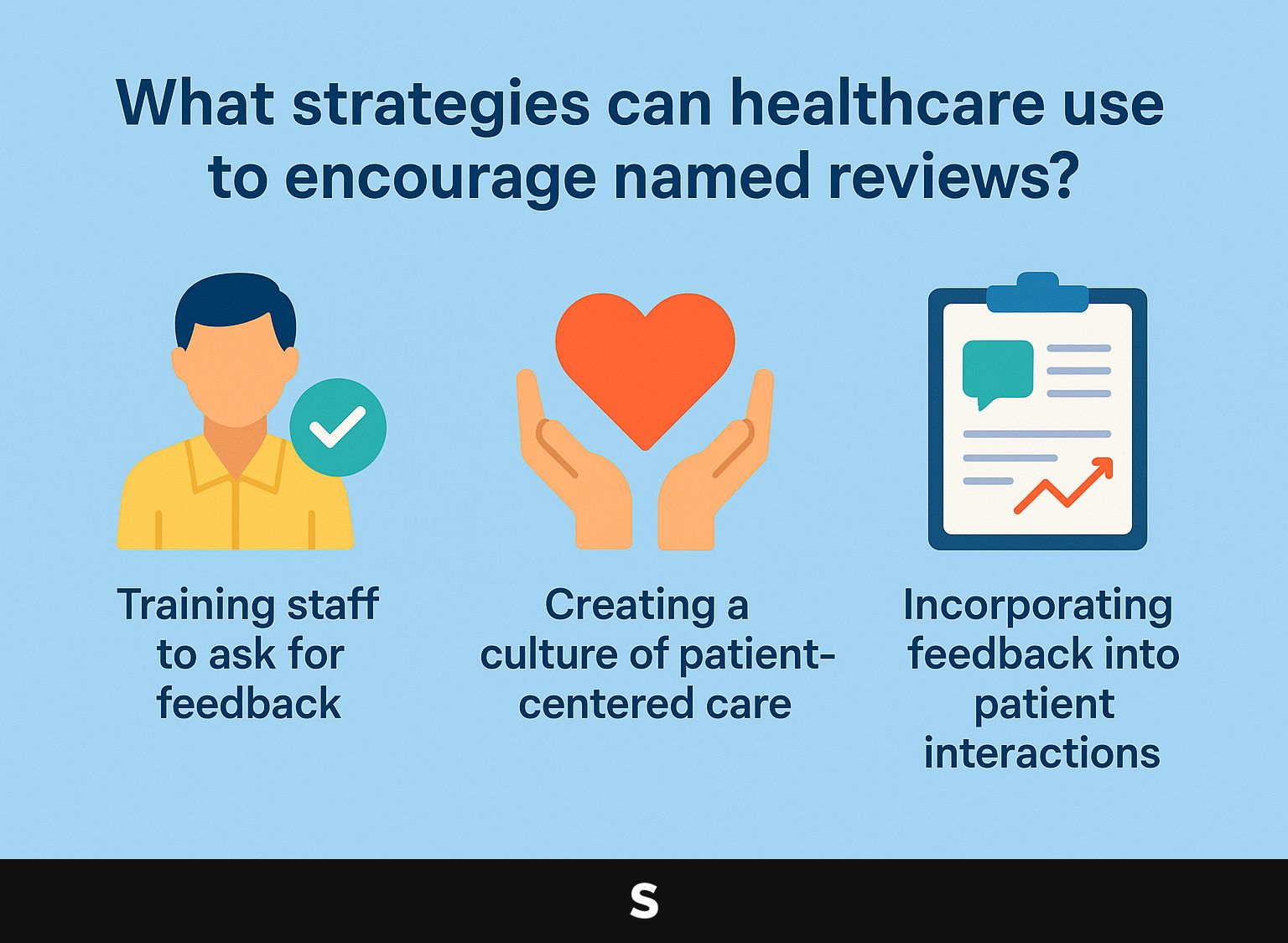
Training staff to ask for feedback
Teaching healthcare staff to request feedback from patients can significantly raise the number of reviews with names.
Implement structured role-playing scenarios during training sessions. For example, simulate patient interactions where staff members practice asking open-ended questions like, “Can you share your thoughts on your recent visit?” This encourages a comfortable dialogue.
Organize workshops to teach effective techniques for requesting feedback, emphasizing the importance of gratitude and follow-up. Staff can use survey tools like SurveyMonkey or Google Forms to make feedback collection easier.
By giving teams these skills, healthcare facilities can improve patient involvement and gain useful information.
Creating a culture of patient-centered care
Establishing a culture of patient-centered care can naturally lead to more instances of patients feeling compelled to share named feedback.
To create this environment, healthcare organizations can implement several practical steps.
- Begin by training staff on empathy and communication skills, ensuring they understand the importance of listening to patient concerns.
- Set up regular meetings for staff and patients to talk about their experiences openly.
- Use tools like patient satisfaction surveys to gather data, while actively responding to feedback to show that you value patient input.
- Creating a welcoming environment and offering cozy waiting areas can make patients feel better, encouraging them to share their positive experiences.
Incorporating feedback into patient interactions
Including patient feedback in regular conversations can increase the chances of getting positive reviews, as patients feel their opinions matter.
To effectively integrate feedback, establish regular check-ins, such as monthly discussions, where patients can share their experiences.
Use tools like patient satisfaction surveys or online services like SurveyMonkey to keep responses anonymous.
Summarize what patients share and talk about how it affects their care plans in follow-up visits. This ongoing conversation makes patients feel valued and builds trust, which improves the quality of care.
How can healthcare facilities promote their staff through reviews?
Healthcare facilities can use positive patient reviews to showcase their staff, effectively turning feedback into a marketing tool that emphasizes team skill and quality.
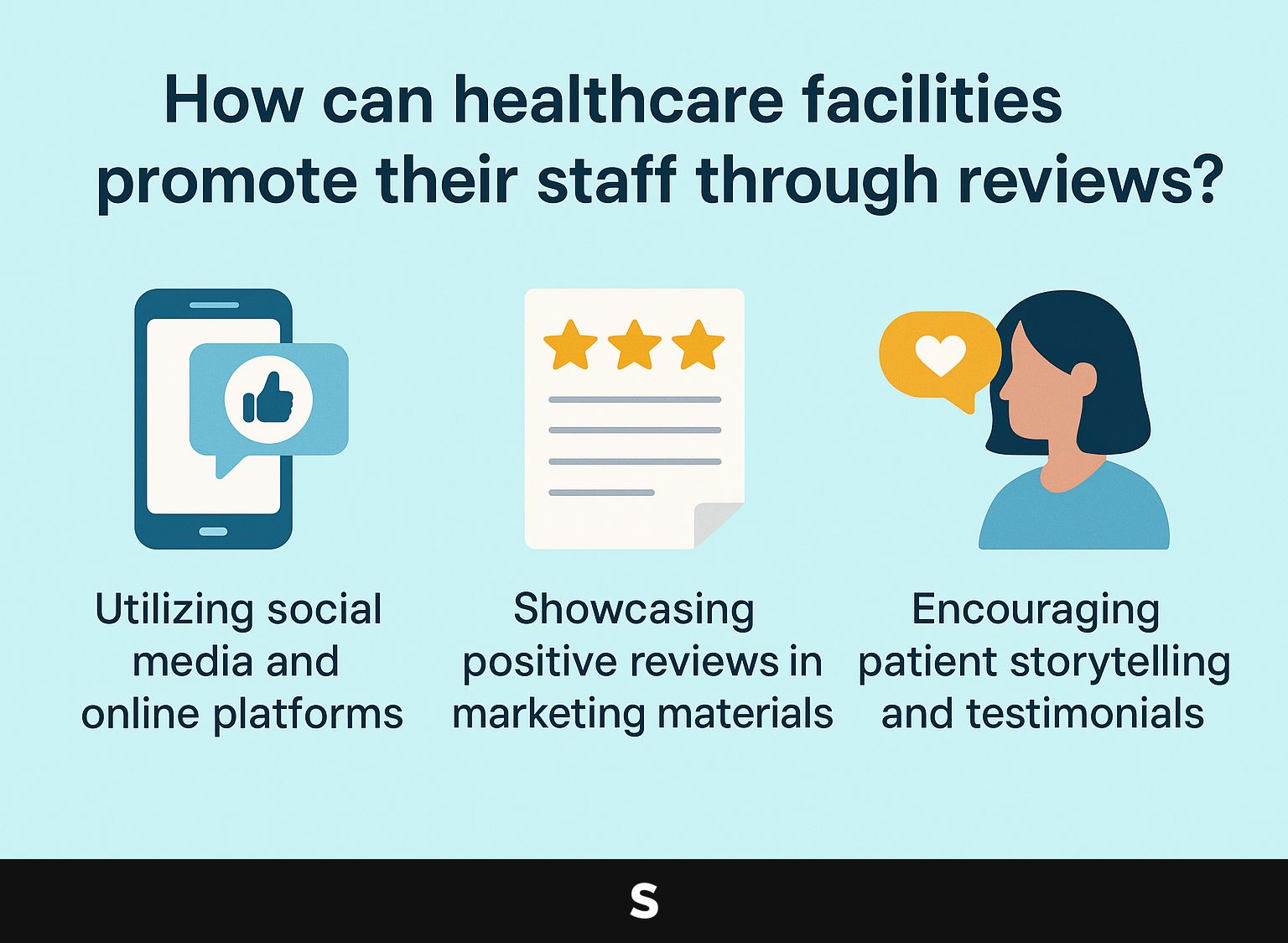
Healthcare providers can use social media to share positive patient feedback and give special attention to their staff members, increasing their visibility.
To effectively promote staff on social media, consider using platforms like Facebook, Instagram, and LinkedIn.
Create engaging highlight posts that feature staff achievements; for example, a monthly ‘Employee Spotlight’ can celebrate individual contributions.
Video testimonials from happy patients, posted on YouTube or Instagram, can make your staff feel more relatable and build trust.
Motivate staff to share their stories and knowledge through blog posts or Instagram Stories, highlighting their skills and enthusiasm for patient care. This method improves morale and builds stronger community connections.
Showcasing positive reviews in marketing materials
Including positive reviews in marketing materials can greatly increase the attractiveness of healthcare services. This helps attract new patients and highlights the abilities of the staff.
To effectively integrate reviews, consider placing them prominently on your website’s homepage and service pages, using a clean design with patient photos if possible.
For brochures, a dedicated testimonial section can provide quick quotes alongside visuals.
In advertisements, use parts of reviews or ratings as catchy headlines. Tools like Canva can help design these materials with easy-to-use templates.
Make sure reviews are up-to-date and related to build trust and show your dedication to keeping patients happy.
Encouraging patient storytelling and testimonials
Encouraging patients to share their stories and testimonials can provide powerful narrative content that illustrates staff effectiveness and patient care quality.
To encourage patients to respond, think about sending custom follow-up emails after their appointments, asking them to talk about their visits.
Organize dedicated storytelling events where patients can express their narratives in a supportive environment.
Another method involves creating an online platform or social media group, allowing patients to post their stories and connect with others.
Make sure staff listen to these stories and show patients that their voices matter. This method improves your storytelling content and helps build a sense of togetherness among patients.
What role does AI play in managing patient feedback?
AI technologies are important for handling patient feedback automatically, ensuring the process runs smoothly and follows rules. For a comprehensive understanding of how AI is transforming customer interactions, consider exploring our deep dive into revolutionizing customer experience with artificial intelligence.
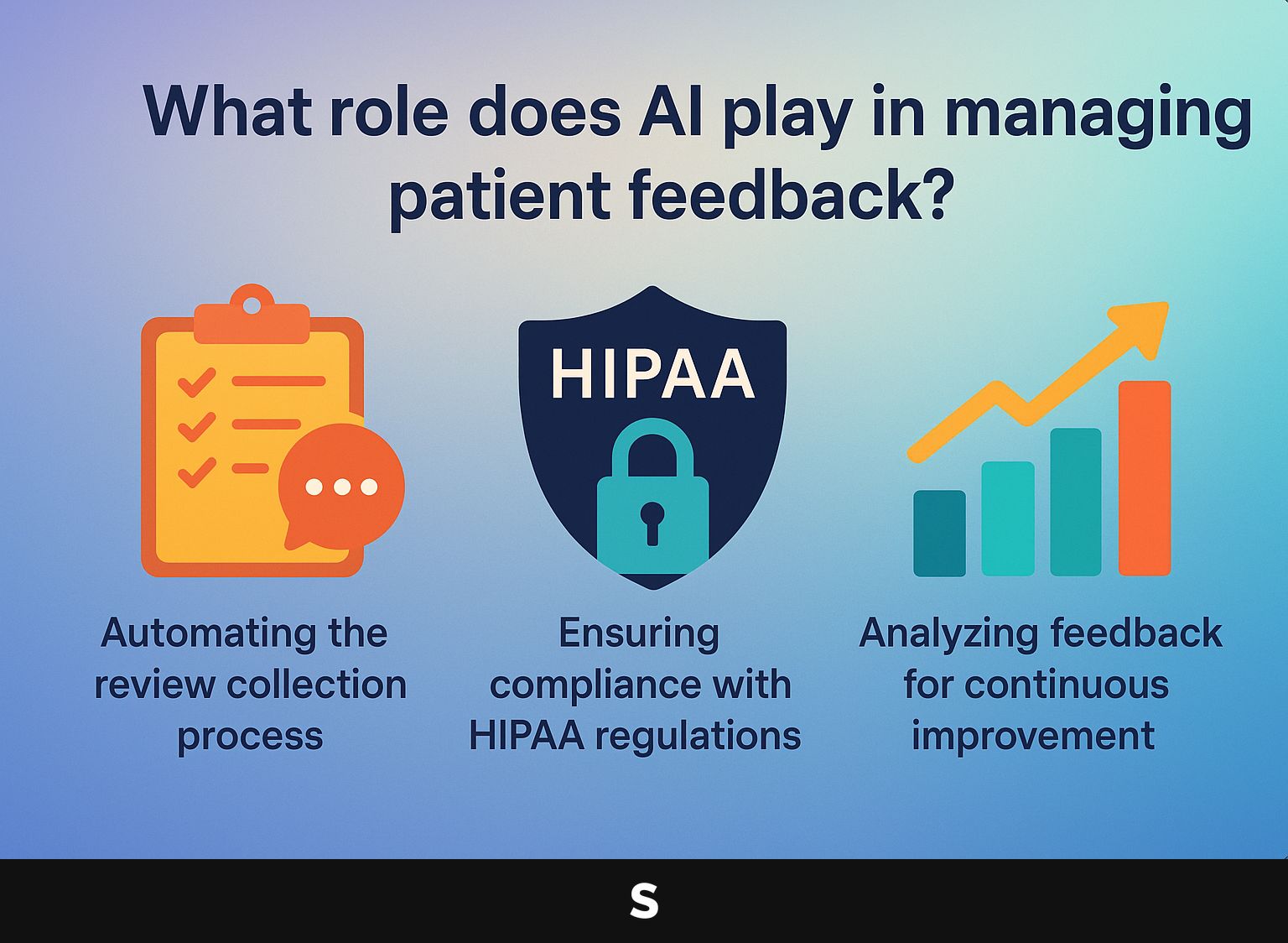
Automating the review collection process
AI can manage the task of gathering reviews, simplifying how healthcare providers collect and examine patient feedback.
Providers can use software like PatientPop that connects with scheduling systems to automatically send review requests through email or SMS after an appointment. This tool can improve response rates by customizing messages according to the patient’s visit experience.
A different choice is Podium, which gathers reviews and lets you chat with patients instantly to get quick feedback.
By setting up these systems, healthcare providers can quickly gather important information, improve patient satisfaction, and create a strong online presence.
Ensuring compliance with HIPAA regulations
AI-powered tools make sure that gathering patient feedback follows HIPAA rules, protecting patient privacy and keeping data secure.
Spokk.io includes important tools to keep HIPAA compliance during the review process. End-to-end encryption is used to keep patient data safe when it is sent, so only people with permission can see private details.
Spokk.io automatically keeps records of who views patient data, ensuring responsibility and the ability to track access. It has a user-access management system to limit data exposure to only essential personnel.
By using these methods, Spokk.io meets compliance standards and gains patients’ trust in their data privacy.
Analyzing feedback for continuous improvement
Using AI to study patient feedback can find useful information that helps improve healthcare services.
To effectively analyze patient feedback, focus on key metrics such as sentiment analysis, response trends, and service ratings.
Tools like Natural Language Processing (NLP) algorithms can sift through comments to identify predominant themes, revealing areas that may need attention.
For example, platforms like Qualtrics and Medallia provide strong analysis tools that show changes in how satisfied or dissatisfied patients are over a period.
Using A/B testing on updated service methods can show clear proof of improvement, allowing decisions based on patient feedback.
How can healthcare providers respond to patient reviews?
Responding to patient reviews effectively can increase involvement, build trust, and show dedication to quality care.
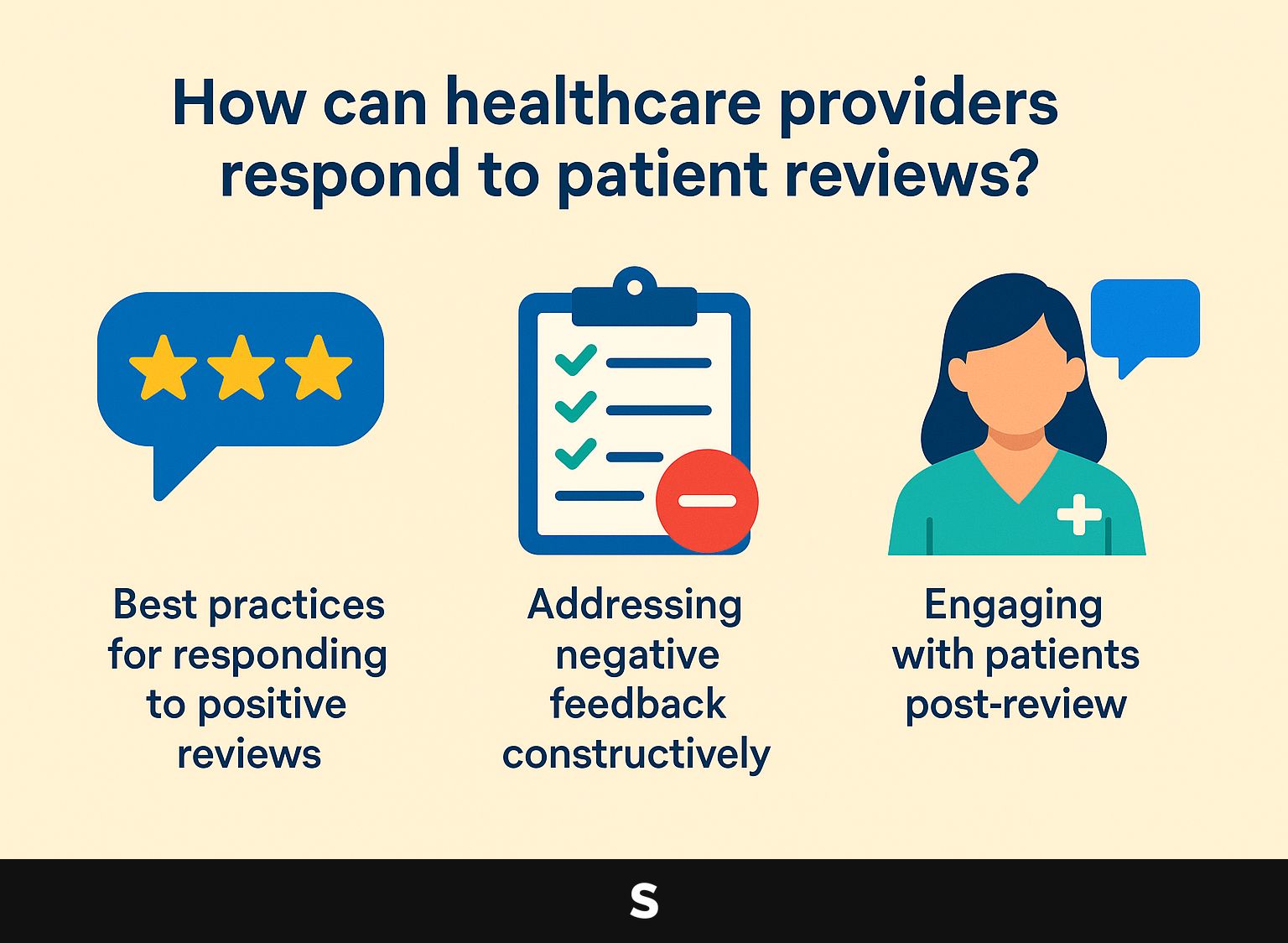
Best practices for responding to positive reviews
When replying to good reviews, healthcare providers should recognize the comments and thank the reviewer to build a lasting connection.
Start by using the patient’s name to create a personal connection, such as, “Thank you, Sarah, for your kind words!”
Reference their specific comments, like their appreciation for timely service or compassionate care. For example, “We’re thrilled to hear you felt welcomed and well-cared for during your visit.”
Conclude with an invitation for further engagement, such as, “We look forward to seeing you at your next appointment!”
This method strengthens a positive experience and motivates people to engage again.
Addressing negative feedback constructively
Constructively addressing negative feedback is critical for maintaining patient trust and demonstrating a commitment to improvement.
Begin by acknowledging the patient’s concerns. Use language like, “I understand how you feel and appreciate you bringing this to my attention.” This shows empathy and makes the patient feel heard.
Next, suggest a solution by saying, “To fix this, I can schedule another appointment or make sure our staff is trained again in customer service.”
Invite more discussion by saying, “Please contact me if you have any other questions.” This solves the issue and shows you care about them.
Engaging with patients post-review
Checking in with patients after reviews helps create trust and encourages them to give feedback later, which helps us keep getting better.
To make this interaction better, think about sending individual thank-you notes after getting feedback. A handwritten note can make patients feel appreciated and important, building loyalty.
Invite them to a follow-up conversation, either through a phone call or a scheduled appointment, to discuss their experiences further. Tools like SurveyMonkey can gather feedback from past reviews, ensuring you address any problems.
Maintaining consistent communication through newsletters or updates on practice changes can keep patients engaged and informed, cultivating a thriving practice community.
What are the challenges in obtaining patient reviews?
Healthcare providers benefit from patient reviews, but they often encounter difficulties that make it hard to gather feedback.
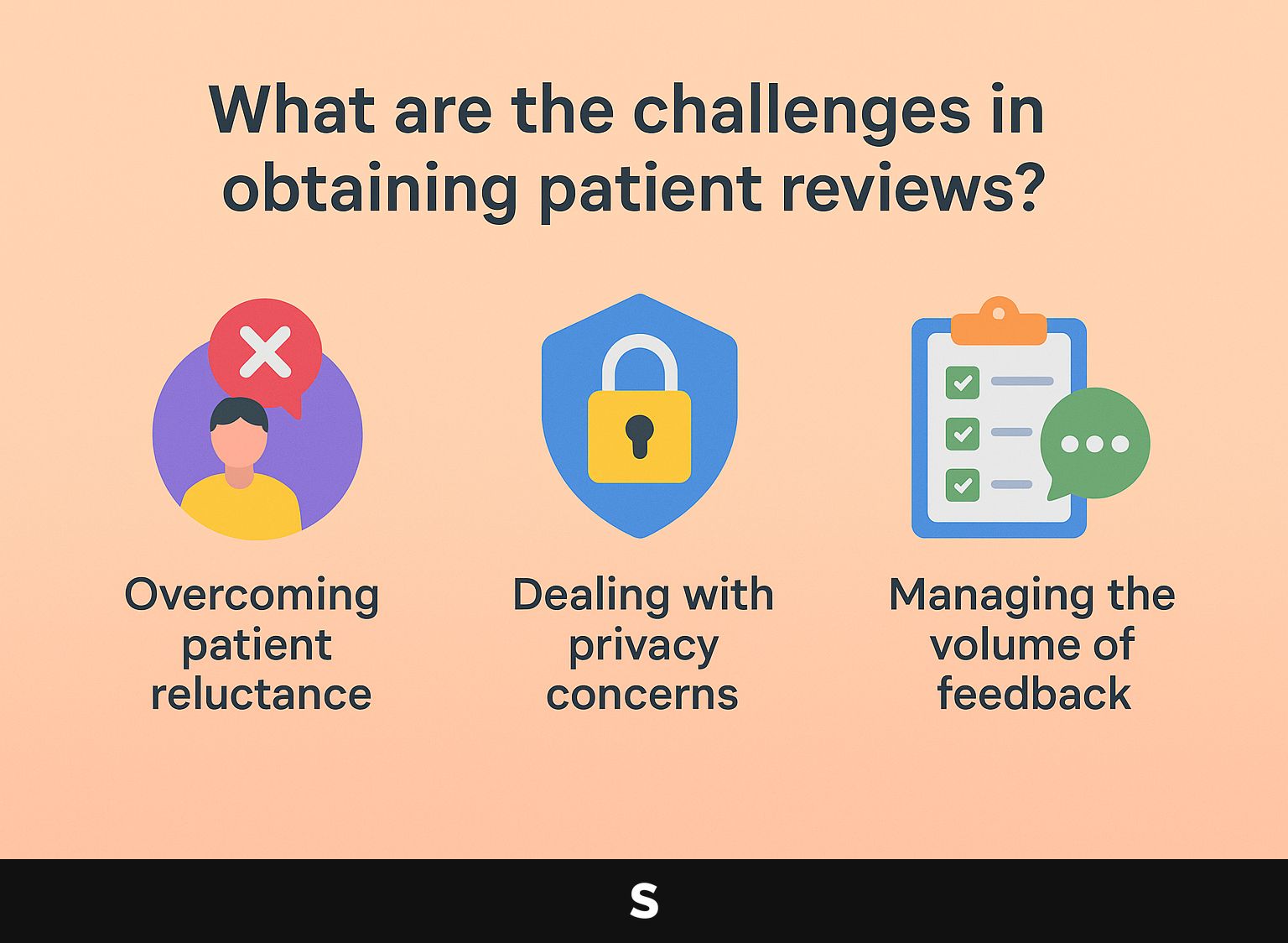
Many patients are hesitant to share their healthcare experiences due to various factors, including privacy concerns and lack of motivation.
To get patients to share their thoughts, healthcare providers can try different approaches.
- Send review requests quickly after visits to take advantage of the fresh experience.
- Use easy-to-use platforms like SurveyMonkey or Google Forms to make the review process simple and fast.
- Consider offering small incentives, such as discounts on upcoming services or contributions to charity, when reviews are completed.
- Regularly talk about the importance of feedback, showing how it helps make care better and improves the patient experience.
Dealing with privacy concerns
Privacy worries are a major obstacle to getting patient reviews because people want to keep their information private and safe.
Healthcare providers can address these concerns by emphasizing their commitment to HIPAA compliance, which mandates strict safeguards for personal health information.
Using encrypted tools for talking with patients, like secure messaging apps, builds trust. Regular staff training on data privacy gives patients more confidence in their promise to keep information private.
Displaying certifications and privacy policies transparently on websites also invites confidence. By talking to patients about their data rights and the steps taken to protect them, providers can build a trusting environment that encourages positive feedback.
Managing the volume of feedback
Healthcare providers often struggle with managing a high volume of patient feedback, which can overwhelm staff and hinder timely responses.
To handle this feedback better, consider using review management tools like BirdEye or Trustpilot, which simplify the process.
Establish regular intervals for reviewing feedback-daily for urgent concerns and weekly for general input.
Reply to bad reviews within a day to show you care, and thank users for good reviews once a month to keep the conversation going.
Group feedback into common topics to find repeated problems and improve services. This organized method helps keep your team quick to respond and actively improve how happy patients are.
What new developments are appearing in patient review systems?
Recent updates in patient review systems show a move towards creating more personalized experiences and stronger connections with healthcare technologies, which improves feedback management. To explore how technology enhances patient interactions, our discussion on customer experience and technology offers valuable insights.
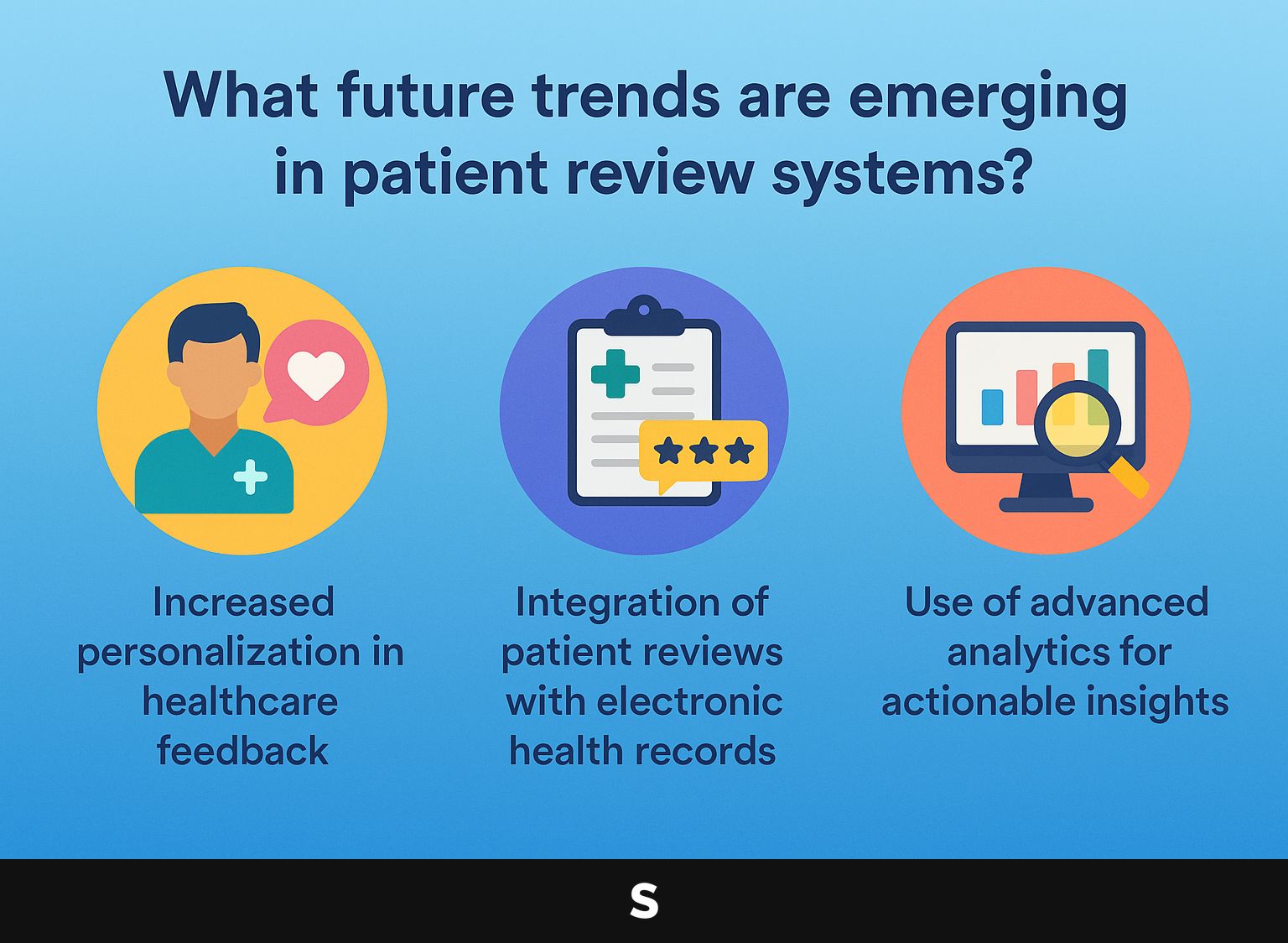
Increased personalization in healthcare feedback
The move towards personalized healthcare aims to improve communication between patients and healthcare professionals, making it more meaningful and useful.
To gather personal feedback, many healthcare providers use tools like Medallia and Qualtrics. These tools use algorithms to customize surveys based on patient history.
For instance, using Medallia, clinics can send targeted questions to specific patient demographics after appointments, ensuring that feedback is relevant.
Using SMS surveys through platforms like SimpleTexting can connect with patients through their preferred way of communication, which can lead to better response rates.
These strategies increase patient participation and offer practical ideas for better care.
Integration of patient reviews with electronic health records
Linking patient feedback with electronic health records (EHRs) is gaining traction. This combination offers a thorough look at patient experiences.
This integration offers many key benefits. It improves patient care by giving healthcare providers immediate access to feedback, allowing them to quickly deal with issues.
Technologies like ReviewWave or BirdEye facilitate this integration, automatically syncing reviews into EHR systems. Simple feedback analysis helps find patterns, letting practices change services regularly.
For instance, if multiple patients comment on long wait times, a practice can implement changes to improve scheduling. These tools improve patient satisfaction and make operations more efficient.
Use thorough data analysis to gain practical knowledge
Using advanced data analysis on patient feedback can find useful information that helps make both operational and clinical improvements.
By looking at measurements like patient satisfaction scores, Net Promoter Scores (NPS), and how quickly complaints are resolved, healthcare providers can spot patterns and areas that need improvement.
For example, a sudden drop in NPS might indicate issues with staff communication or service quality. Using tools such as Qualtrics or Medallia helps hospitals to collect and study these metrics quickly.
Looking at this data often helps identify specific issues and decide which staff training and operational changes are most important. This leads to better experiences and results for patients.
Frequently Asked Questions
What is Spokk.io’s unique staff attribution feature?
Spokk.io’s special staff attribution tool makes sure healthcare reviews highlight and give credit to specific team members.
How does Spokk.io gather patient reviews that mention medical staff by name?
Patients are able to select their doctor or nurse and provide brief feedback on their experience, which is then compiled by AI into HIPAA-compliant reviews.
Why is it important to get patient reviews that mention medical staff by name?
Collecting patient reviews that include names of medical staff gives a clear and individual view of each team member’s role and effect on patients.
How does Spokk.io keep patient reviews in line with HIPAA rules?
Spokk.io’s AI technology makes sure that patient reviews follow HIPAA rules, keeping patient privacy and confidentiality safe.
Can patients leave negative reviews that mention medical staff by name?
Yes, patients are able to leave both positive and negative reviews that mention medical staff by name, providing a well-rounded and honest representation of their experience.
What are the benefits of using Spokk.io’s staff attribution feature for healthcare reviews?
Spokk.io’s staff attribution tool provides clear and detailed information on each team member’s effect on patient experiences, helping to raise patient satisfaction and trust in the healthcare system.

